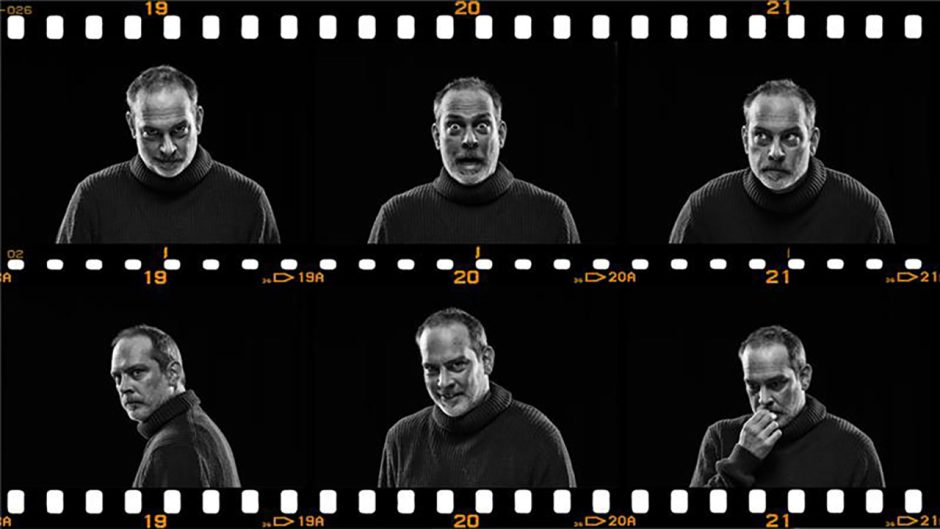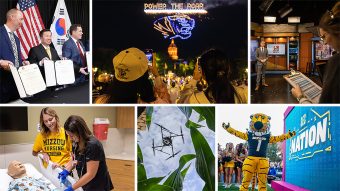
Oct. 23, 2025
Contact: Sara Diedrich, diedrichs@missouri.edu
Photos by Abbie Lankitus
We like to scare each other.
It’s exhilarating in a twisted, uniquely human way — frightening yet cathartic — a clash of emotions first harnessed by oral storytelling, then carried into literature and eventually film.
Horror is weirdly fun and consistently popular.
Just ask Ramsay Wise, assistant teaching professor in the School of Visual Studies at the University of Missouri’s College of Arts and Science. He has taught film at Mizzou for more than 20 years, and his horror course is always packed.
“Horror films are a fantastic tool for teaching both film study and film history,” Wise said. “The genre is incredibly versatile, with a wide range of subgenres. Ask someone about their favorite horror movie and you might hear anything from a haunted house story to a slasher, a gore-filled spectacle, a psychological thriller or even a self-aware satire. Horror is endlessly malleable.”
The genre is also a gift for up-and-coming filmmakers.
“Horror can often be produced on a smaller budget,” Wise said. “With spooky lighting and a few clever tricks, you can create atmosphere and tension. The genre comes with built-in audience expectations, and as long as you find a way to twist those conventions into something fresh, you just might have a hit.”
Anatomy of horror
Horror is never static — it evolves with society. What frightens us today is not what haunted people in 1896 when the first horror film was made, a three-minute clip known as “The Haunted Castle” or “The House of the Devil.”
Although horror frequently relies on blood and gore for shock value, Wise favors films that carry “an intellectual drive” beneath the violence.
“That’s what draws me in, the deeper human truths,” he said. “Don’t get me wrong, there’s a time and place for pure shock, but it only works when it’s grounded in something genuinely compelling.”
Still, horror has always given people a safe space to face their darkest fears.
“In the end, the one universal truth is we’re all going to die,” Wise said. “We have to somehow work that out, and we do it through storytelling and art.”
Today’s audiences are far more visually literate than in the past, which can make them skeptical, even cynical, about the special effects in older horror films.
“Take ‘Jaws,’ for example,” Wise said. “When it premiered, it was a cultural phenomenon. People lined up around city blocks just to be terrified by that shark. But younger audiences don’t buy into it the same way. Technology has advanced, and their expectations are higher.”
How to watch a horror film
For Wise, the best way to watch a horror film is on a big screen in a dark room without interruptions. Ideally, in a crowded movie theater and certainly not on a cell phone. Today’s students often have to relearn how to watch movies. At the beginning of each semester, Wise screens a film in a theater setting to remind them of the theatrical experience, which is far different from watching on a laptop or phone.
“A theater is both communal and private: You sit in the dark with a crowd, sharing the same reactions, yet at the same time you’re absorbed in your own experience of the film,” he said. “It’s a paradoxical space where you can be alone and anonymous but still part of a collective moment.”
This Halloween season, turn off your phone, dim the lights and fire up the biggest screen you have for a horror film. Even better, invite friends and family to share in a collective scream. After all, horror is fun — strangely, wonderfully fun.
Ready to dive in? Here are some of Wise’s top picks for your Halloween watch list.
“The Shining” (1980) — Jack Nicholson’s descent into madness turns a snowbound hotel into one of horror’s most chilling playgrounds. Redrum, anyone?
“The Bride of Frankenstein” (1935) — A gothic gem where monsters aren’t just made — they’re married. Campy, creepy and surprisingly tender.
“Psycho” (1960) — Alfred Hitchcock proves you’ll never feel safe in the shower again with this nerve-shredding classic of suspense and slashing.
“The Birds” (1963) — Hitchcock strikes again, unleashing a feathery nightmare that turns small-town California into a birds-gone-mad apocalypse.
“Nosferatu” (1922) — Silent, sinister and still spine-tingling after a century, Count Orlok’s shadowy creep defines vampire horror.



